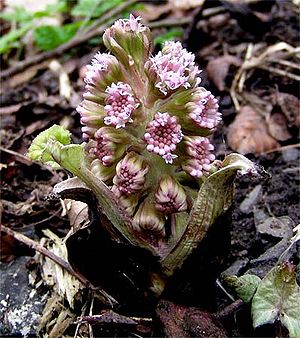Difference between revisions of "Petasites"
Jump to navigation
Jump to search
m (1 revision: From PNW foraging book - part 1) |
(cut down) |
||
| Line 1: | Line 1: | ||
| − | |||
{{taxobox | {{taxobox | ||
|image = Butterbur.jpg | |image = Butterbur.jpg | ||
| Line 16: | Line 15: | ||
|}} | |}} | ||
[[File:Petasites japonicus Russia.JPG|thumb|right|''[[Petasites japonicus]]'']] | [[File:Petasites japonicus Russia.JPG|thumb|right|''[[Petasites japonicus]]'']] | ||
| − | |||
| − | + | '''''Petasites''''' is a genus of [[flowering plant]]s in the sunflower family, [[Asteraceae]], that are commonly referred to as '''butterburs'''<ref name=Stace>{{cite book|last=Stace|first=C. A.|authorlink = Stace, C. A.|year=2010|title=New Flora of the British Isles|edition=Third|publisher=Cambridge University Press|location = Cambridge, U.K.| isbn=9780521707725}}</ref><ref>Miller, Philip. 1754. Gardeners Dictionary...Abridged...fourth edition page 1056.</ref><ref>[http://www.tropicos.org/Name/40005373 Tropicos, ''Petasites'' Mill.]</ref> and '''coltsfoots'''.<ref name=fna>[http://www.efloras.org/florataxon.aspx?flora_id=1&taxon_id=124686 ''Petasites''.] Flora of North America. Volume 20, Page 635. efloras.org.</ref> | |
| − | |||
| − | |||
| − | |||
| − | |||
| − | '' | ||
| − | |||
| − | |||
| − | |||
| − | |||
| − | |||
| − | |||
| − | |||
| − | |||
| − | |||
| − | |||
==Species== | ==Species== | ||
| Line 68: | Line 51: | ||
{{Reflist|30em}} | {{Reflist|30em}} | ||
| − | + | [[Category:Asteraceae]] | |
| − | + | [[Category:Plants for Keenan to eat]] | |
| − | |||
| − | |||
| − | |||
| − | |||
| − | |||
| − | [[Category:Asteraceae | ||
| − | |||
| − | [[Category: | ||
Latest revision as of 19:23, 13 September 2018
| Petasites | |
|---|---|

| |
| Petasites hybridus | |
| Scientific classification | |
| Kingdom: | |
| (unranked): | |
| (unranked): | |
| (unranked): | |
| Order: | |
| Family: | |
| Tribe: | |
| Genus: | Petasites |
| Synonyms[1] | |
|
Nardosmia Cass. | |
Petasites is a genus of flowering plants in the sunflower family, Asteraceae, that are commonly referred to as butterburs[2][3][4] and coltsfoots.[5]
Species
- Petasites albus White Butterbur - Europe, Algeria, Turkey, Caucasus, India
- Petasites fominii - Republic of Georgia
- Petasites formosanus - Taiwan
- Petasites frigidus Arctic Butterbur or Arctic Sweet Coltsfoot - Scandinavia, Mongolia, Canada, northern USA
- Petasites hybridus Common Butterbur - Europe, Mediterranean
- Petasites japonicus Giant Butterbur, or Fuki - China, Japan, Korea
- Petasites kablikianus - southeastern Europe from Poland to Albania
- Petasites kamengicus - Arunachal Pradesh
- Petasites paradoxus - central + southwestern Europe from Spain to Poland
- Petasites pyrenaicus from Azores to Ireland + Tunisia
- Petasites radiatus - Mongolia
- Petasites rubellus - Mongolia, Manchuria, Korea
- Petasites sibiricus - Siberia
- Petasites spurius - Europe, Siberia, Caucasus, Central Asia
- Petasites tatewakianus - Siberia, Russian Far East, northeastern China
- Petasites tricholobus - China, Vietnam, Himalayas
- Petasites versipilus - Sichuan, Yunnan
- Species of hybrid origin[1]
- Petasites × vitifolius
- Species formerly included[1]
Petasites glacialis (Ledeb.) Polunin - Endocellion glaciale (Ledeb.) Toman
Other species:
Petasites fragrans (Vill.) C.Presl[7][8]
References
- ↑ 1.0 1.1 1.2 1.3 1.4 Flann, C (ed) 2009+ Global Compositae Checklist Archived 2014-12-11 at Archive.is
- ↑ Stace, C. A. (2010). New Flora of the British Isles (Third ed.). Cambridge, U.K.: Cambridge University Press. ISBN 9780521707725.
- ↑ Miller, Philip. 1754. Gardeners Dictionary...Abridged...fourth edition page 1056.
- ↑ Tropicos, Petasites Mill.
- ↑ Petasites. Flora of North America. Volume 20, Page 635. efloras.org.
- ↑ "Search results — The Plant List". theplantlist.org.
- ↑ Clapham, A.R., Tutin, T.G. and Warburg. 1968. Excursion Flora of the British Isles. Cambridge University Press. <templatestyles src="Module:Citation/CS1/styles.css" />ISBN 0-521-04656-4
- ↑ Parnell, J. and Curtis, T. 2012. Webb's An Irish Flora. Cork University Press. <templatestyles src="Module:Citation/CS1/styles.css" />ISBN 978-185918-4783
